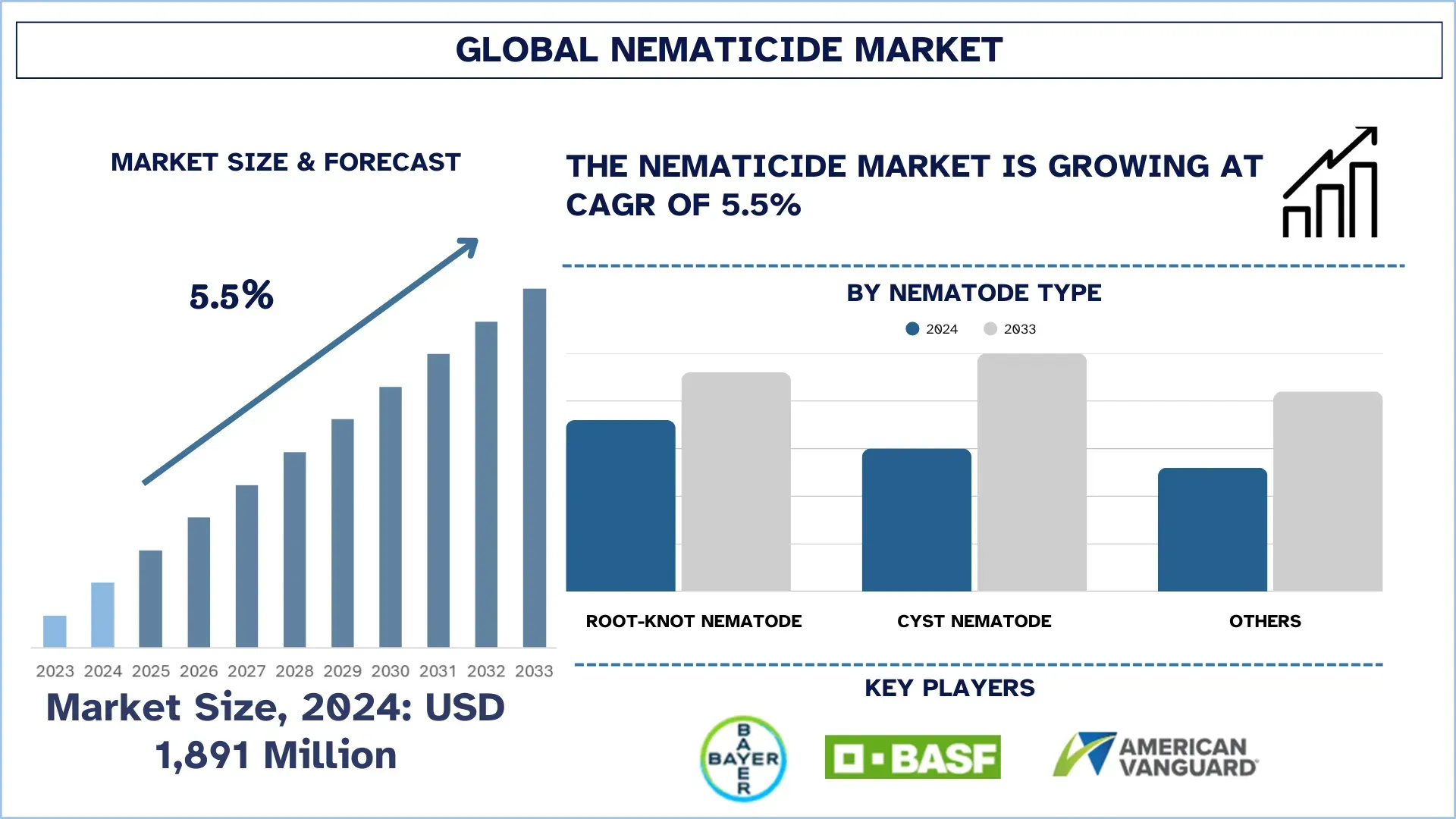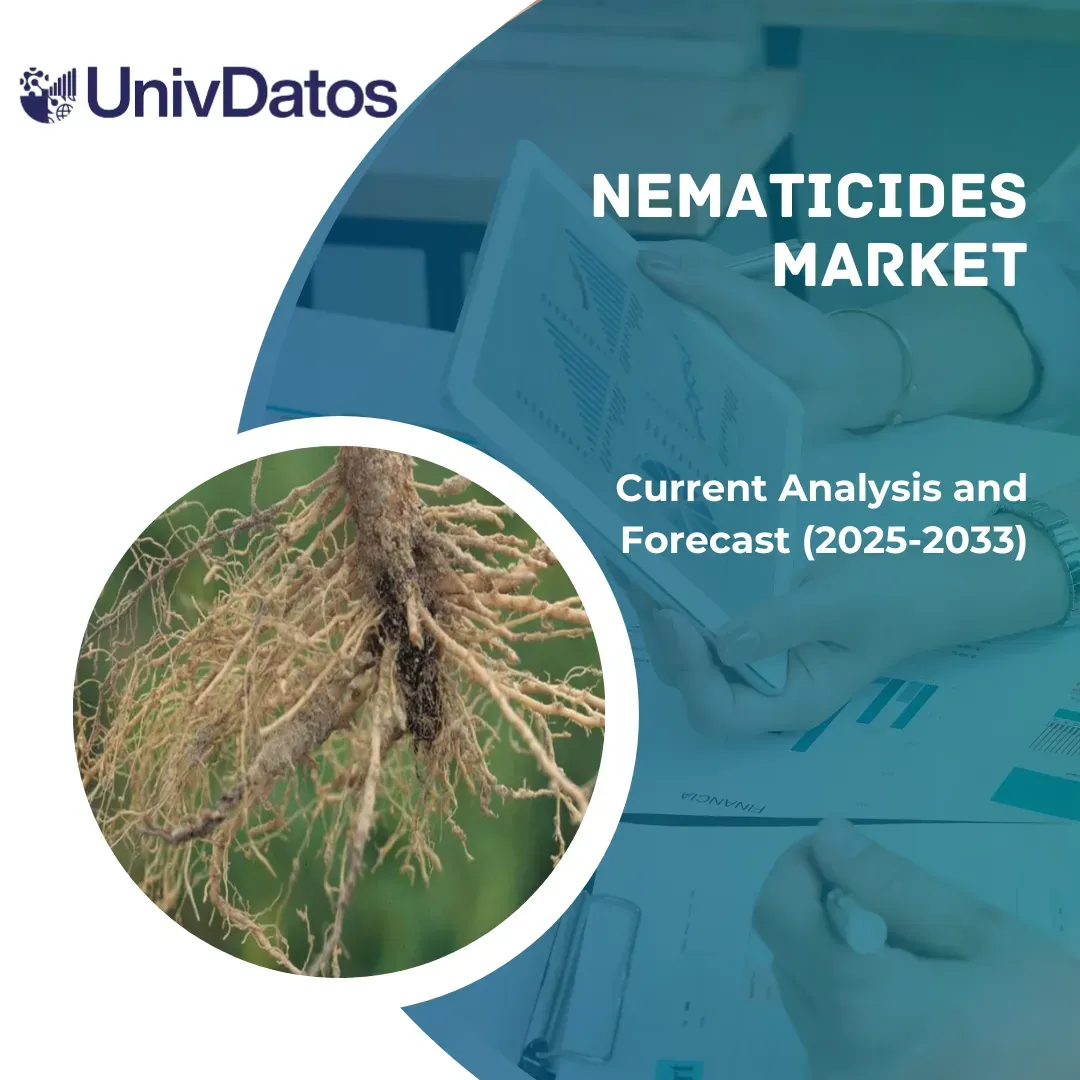
Global Nematicides Market Size & Forecast
The Global Nematicides Market was valued at USD 1,891 million in 2024 and is expected to grow at a strong CAGR of around 5.5% during the forecast period (2025-2033F), driven by rising crop losses from nematode infestations, which significantly impact global food security and farmer profitability.
Nematicides Market Analysis
A nematicide is a form of chemical or biological substance specifically formulated to manage or destroy plant-parasitic nematodes, or microscopic roundworms that infest the roots of agricultural crops, reducing their growth and yield, as well as lowering their quality. Nematicides may also be synthetic, naturally occurring, or bio-based products, and their application can be in the form of soil treatment, seed coating, or foliar sprays. The global nematicide market is on an upward trend because of the increasing threat of the plant-parasitic nematodes that result in significant losses of yield and quality of important crops, including cereals, fruits, and vegetables, and commercial crops. The increasing world food demand, coupled with the need to have sustainable agriculture, is pushing farmers to use efficient nematode management practices.
Global Nematicides Market Trends
This section discusses the key market trends that are influencing the various segments of the global nematicides market, as found by our team of research experts.
Growth in Digital Agriculture Integration
The digital agriculture integration is emerging as a core trend in the global nematicides market as farmers start the application of advanced technologies to protect crops in the most efficient way. Drone technology, remote sensing, AI-based crop monitoring systems, and precision application systems enable the accurate identification of nematode infestations, allowing targeted nematicides to be used effectively in addressing these infestations. This enhances the efficiency of the applications, besides minimising the input costs and environmental degradation. There are also digital platforms that offer real-time data regarding soil health, and this is beneficial to the integrated pest management (IPM) strategies. With the adoption of data-led farming in agribusinesses, digital agriculture will revolutionize the use of nematicides, which will result in sustainable growth and market expansion over time.
Nematicides Industry Segmentation
This section provides an analysis of the key trends in each segment of the global nematicides market report, along with forecasts at the global, regional, and country levels for 2025-2033.
The fumigants Segment Dominates the Global Nematicides Market
Based on the chemical type category, the market is categorised into fumigants, organophosphates, carbamates, bio-nematicides, and others. Among these, fumigants hold the maximum market share in the nematicide market due to their broad-spectrum activity, fast-acting properties, and common use in high-value crops such as vegetables, fruits, and commercial crops. However, the bio-nematicides segment is expected to experience the most rapid growth, driven by the global trend towards sustainable agriculture and the regulations that support biological crop protection methods.
The Grains and Cereals Segment Dominates the Global Nematicides Market.
Based on the application category, the market is segmented into grains and cereals, pulses and oilseeds, commercial crops, fruits and vegetables, and others. Among these, the grains and cereals segment holds the largest market share because of the large-scale farming of cereal crops such as wheat, maize, and rice that are very prone to infestation by nematodes such as root-knot and cyst nematodes. However, in the future, the fruits and Vegetables segment is expected to grow with the fastest CAGR. This is due to the fact that these crops have a high economic value and are more prone to attacks by nematodes.
North America holds the largest market share in the global Nematicides market
North America has a leading market share in the nematicides market because it has a well-developed agricultural infrastructure, a huge production of high-value crops, and a high sensitivity to crop protection methods. Cereals, fruits, vegetables, and commercial crops are susceptible to plant-parasitic nematodes, which pose a major challenge to the area, creating continuous pressure on the need to have effective nematicides. Strong regulatory systems, properly developed distribution channels, and timely use of new chemical and bio-based formulations also increase market leadership. Also, intensive investments in research and development, precision farming technologies, and integrated pest control measures help North American farmers to effectively deal with nematode infestations, which maintains the market leadership in the region.
The United States held a Dominant share of the North America Nematicides Market in 2024
The United States had a leading market share in the North American nematicides market because it undergoes large-scale commercial farming, has vast cultivation of crops that are susceptible to nematodes like corn, soybean, and cotton, and embraces modern crop protection technologies. The sustainable agrochemical firms in the country, with the excellent support of sustainable farming by regulatory bodies, further reinforced their market position. Besides that, the growing tendency to use biological and environmentally friendly nematicides, the popularity of such practices as precision agriculture and integrated pest management (IPM), has strengthened the U.S. nematicides market.
Nematicides Industry Competitive Landscape
The global nematicides market is competitive, with several global and international market players. The key players are adopting different growth strategies to enhance their market presence, such as partnerships, agreements, collaborations, geographical expansions, and mergers and acquisitions.
Top Nematicides Market Companies
Some of the major players in the market are Bayer AG, BASF SE, American Vanguard Corporation, Biobest Group NV, Corteva Agriscience, Novonesis Group, FMC Corporation, Sumitomo Chemical Co., Ltd., Syngenta Crop Protection AG (China National Chemical Corporation), and UPL Ltd.
Recent Developments in the Nematicides Market
-
In January 2025, Bayer entered into an exclusive distribution agreement with UK-based Ecospray to launch a new garlic-derived biological liquid nematicide named Velsinum™ in the EU. The product targets vegetable and potato crops, offering growers a natural alternative to traditional chemical nematicides. Velsinum is designed to combat root damage from nematodes while also supporting plant and soil health.
-
In February 2024, Corteva Agriscience, a global leader in agriculture solutions, announced the launch of Salibro nematicide in India. This innovative product, powered by Reklemel active, provides farmers with a targeted and environmentally friendly solution to protect their crops from damaging nematodes while preserving soil health.
Global Nematicides Market Report Coverage
|
Report Attribute |
Details |
|
Base year |
2024 |
|
Forecast period |
2025-2033 |
|
Growth momentum |
Accelerate at a CAGR of 5.5% |
|
Market size 2024 |
USD 1,891 million |
|
Regional analysis |
North America, Europe, APAC, Rest of the World |
|
Major contributing region |
The Asia-Pacific region is expected to dominate the market during the forecast period. |
|
Key countries covered |
U.S., Canada, Germany, U.K., Spain, Italy, France, China, Japan, and India. |
|
Companies profiled |
Bayer AG, BASF SE, American Vanguard Corporation, Biobest Group NV, Corteva Agriscience, Novonesis Group, FMC Corporation, Sumitomo Chemical Co., Ltd., Syngenta Crop Protection AG (China National Chemical Corporation), and UPL Ltd. |
|
Report Scope |
Market Trends, Drivers, and Restraints; Revenue Estimation and Forecast; Segmentation Analysis; Demand and Supply Side Analysis; Competitive Landscape; Company Profiling |
|
Segments Covered |
By Chemical Type, By Nematode Type, By Formulation, By Application, and By Region/Country |
Reasons to Buy the Nematicides Market Report:
-
The study includes market sizing and forecasting analysis confirmed by authenticated key industry experts.
-
The report briefly reviews overall industry performance at a glance.
-
The report covers an in-depth analysis of prominent industry peers, primarily focusing on key business financials, type portfolios, expansion strategies, and recent developments.
-
Detailed examination of drivers, restraints, key trends, and opportunities prevailing in the industry.
-
The study comprehensively covers the market across different segments.
-
Deep dive regional level analysis of the industry.
Customization Options:
The Global Nematicides Market can further be customized as per the requirements or any other market segment. Besides this, UnivDatos understands that you may have your own business needs; hence, feel free to contact us to get a report that completely suits your requirements.
Research Methodology for the Global Nematicides Market Analysis (2023-2033)
We analyzed the historical market, estimated the current market, and forecasted the future market of the global nematicides market to assess its application in major regions worldwide. We conducted exhaustive secondary research to gather historical market data and estimate the current market size. To validate these insights, we carefully reviewed numerous findings and assumptions. Additionally, we conducted in-depth primary interviews with industry experts across the nematicides value chain. After validating market figures through these interviews, we used both top-down and bottom-up approaches to forecast the overall market size. We then employed market breakdown and data triangulation methods to estimate and analyze the market size of industry segments and sub-segments.
Market Engineering
We employed the data triangulation technique to finalize the overall market estimation and derive precise statistical numbers for each segment and sub-segment of the global nematicides market. We split the data into several segments and sub-segments by analyzing various parameters and trends, including chemical type, nematode type, formulation, application, and regions within the global Nematicides market.
The Main Objective of the Global Nematicides Market Study
The study identifies current and future trends in the global nematicides market, providing strategic insights for investors. It highlights regional market attractiveness, enabling industry participants to tap into untapped markets and gain a first-mover advantage. Other quantitative goals of the studies include:
-
Market Size Analysis: Assess the current and forecast market size of the global nematicides market and its segments in terms of value (USD).
-
Nematicides Market Segmentation: Segments in the study include areas of chemical type, nematode type, formulation, application, and region.
-
Regulatory Framework & Value Chain Analysis: Examine the regulatory framework, value chain, customer behavior, and competitive landscape of the nematicides industry.
-
Regional Analysis: Conduct a detailed regional analysis for key areas such as Asia Pacific, Europe, North America, and the Rest of the World.
-
Company Profiles & Growth Strategies: Company profiles of the nematicides market and the growth strategies adopted by the market players to sustain the fast-growing market.
link

